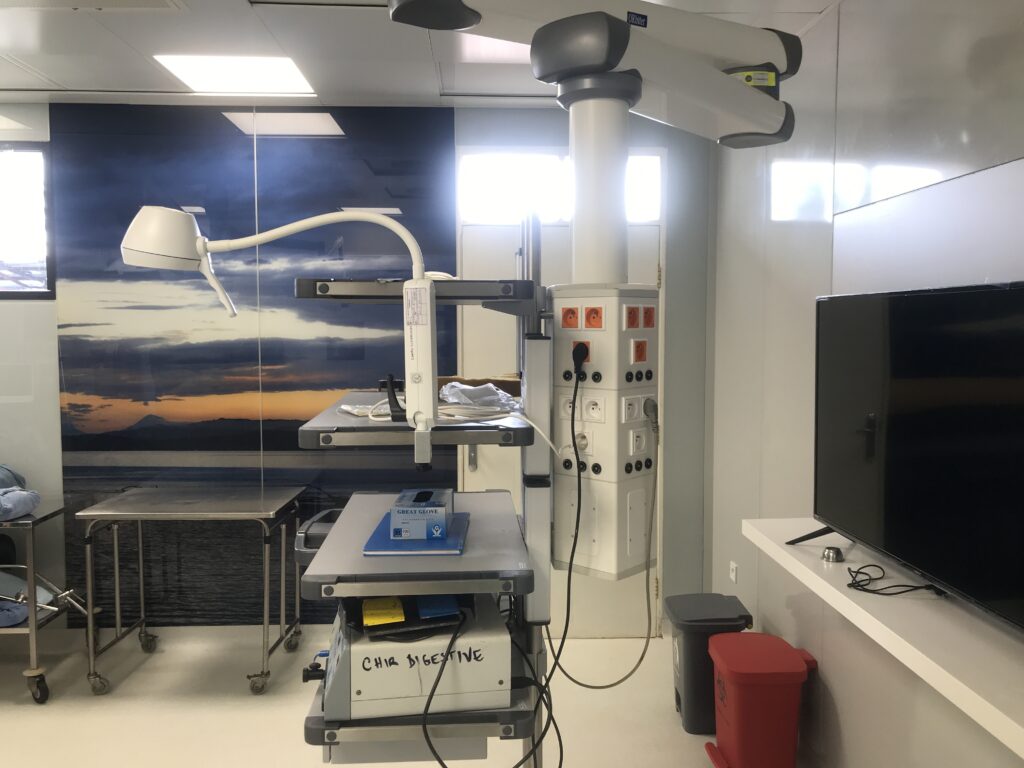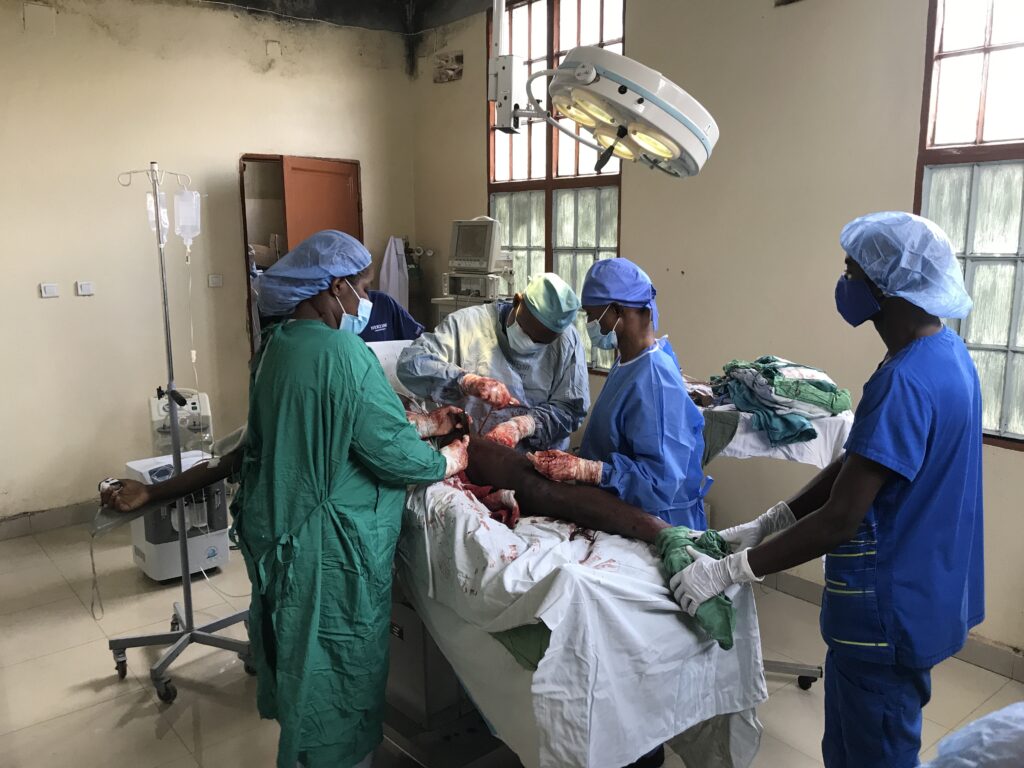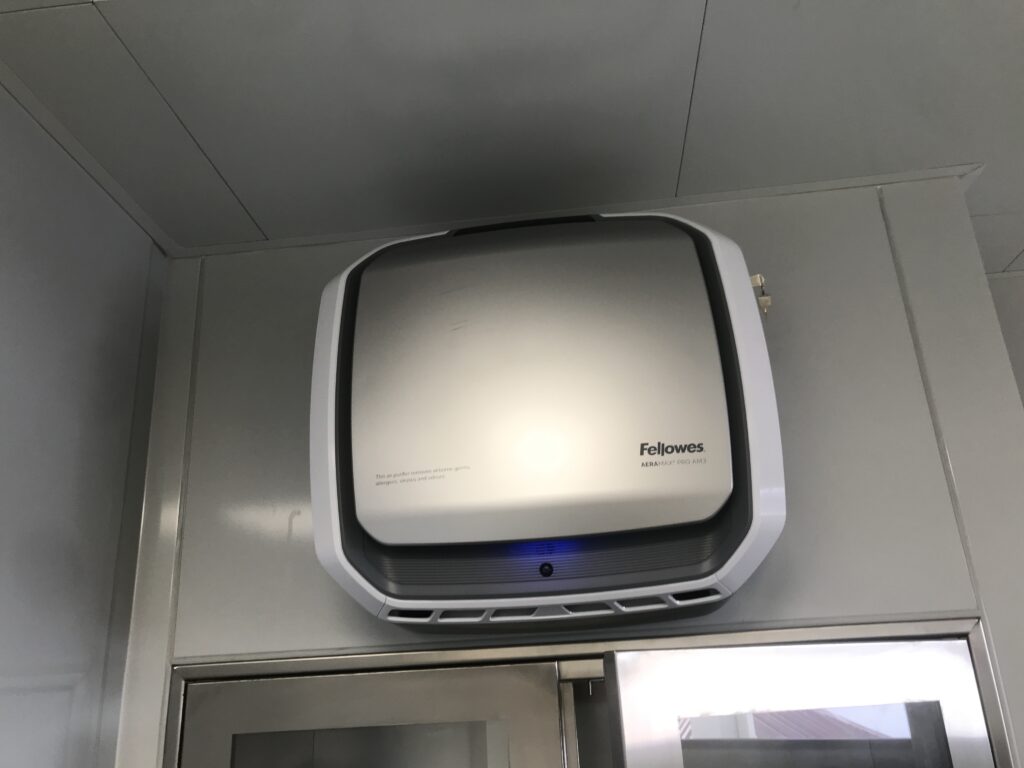
In October 2023, project participants Lars Ekberg, Jörgen Rutegård and Daniel Olsson conducted a reconnaissance trip to the two hospitals in the DR Congo. The purpose of the trip was to prepare for upcoming installations at the end of 2024, create on-site contacts, review the conditions for installation, and make various measurements in the operating theatres.

The hospital staff received us with great kindness and expectations of reduced infection risks in the future. They were very accommodating and gave us full availability to examine the operating theatres and attend any operations we wanted. At the well-known Panzi Hospital, there are two buildings for surgery.
One of them is almost new, with four operating theatres mainly built according to Western standards, while the other building is from the end of the 90s, with four operating theatres of simpler design. The older building is considered as representative of hospitals in Africa. At the much smaller CELPA hospital in central Bukavu, there are two operating theatres in roughly the same condition and design as the older theatres at the Panzi hospital.
Significant air leaks and no mechanical ventilation in the older operating theatres
Bukavu is blessed with a pleasant climate all year round, meaning that few buildings in the city have cooling. Neither do the operating theatres at CELPA and the older at Panzi, and they lack mechanical ventilation. But even though there were many people in the operating theatres, we never experienced stuffy air, which may partly have to do with the generous ceiling heights, partly because the doors, walls, etc. were very leaky. However, cooling has recently been installed in the Panzi hospital’s new operating theatres, which are significantly more airtight. They have chilled filtered return air (similar function as large air purifiers) in three operating theatres and chilled, filtered supply/exhaust air in one. The return air systems are activated with indoor temperature sensors. In those theatres, there are also wall-mounted air purifiers. The fresh air ventilated operating theatre has no purifier, but a filtered airflow rate of 1,000 l/s
Measurements during surgery
Although the Panzi Hospital has primarily become internationally known for the care of women exposed to sexual violence, it provides a variety of other care as well. At the Panzi Hospital, infection-prone surgery, such as orthopaedics, is moved to the new surgery building. In contrast, less infection-prone surgery, such as caesarean sections, is carried out in the older building.

The CELPA hospital also provides varied care and surgery. We witnessed and measured air quality, temperature, moisture, etc., during a total of seven operations, of which two caesarean sections, one proximal femur fracture treated with intramedullary nail (CELPA Hospital), supracondylar femur fracture treated with plate and screwstwo, removal of mammary fibroadenos nodul and two infected vulvar glands. The proximal femur fracture surgery was at the CELPA hospital, but the other six were at the Panzi hospital.
The measurements show potential for improvement
In addition to measurements carried out during operations, measurements were made in empty operating theatres. We measured bacteria content in the air with both passive and active sampling techniques. In addition, we measured temperatures, relative humidity, noise levels, room volumes, air leakage and particle content for different particle sizes.

The latter was done with a fan, blowing air into operating theatres that were alternately sealed and unsealed. The leakage tests were done to estimate supply air flow rates needed to maintain an outward air flow direction from the operating room.
Bacterial levels during surgery varied but were generally very high compared to operating theatres in the Nordics. In the older operating theatres, we measured 1,500 CFU/m3, roughly the same as outdoors. The levels can be compared with the Nordic guidelines (TS39:2015), which state ≤ 10 CFU/m3 during infection-prone surgery and ≤ 100 CFU/m3 during other surgery.
Unfortunately, the ventilation unit in Panzi Hospital’s new surgery building was not running when we measured there during a femur fracture surgery. Therefore, the bacteria content was also high (approx. 900 CFU/m3). In another operation, a lump in a breast was removed tranquilly in one of the new operating theatres with air purifiers and filtered return air. However, since the room temperature did not reach the set point value that starts the ventilation until after 25 minutes, the influence of ventilation could be studied separately. Without return air (but with an air cleaner), the bacteria content was just over 1,200 CFU/m3. With return air, the bacteria content dropped quickly to a bit below 300 CFU/m3. This is still far above Nordic guidelines but significantly better than before.

Unfortunately, the return air flow rate could not be determined, but we could estimate the filter classification to ePM1 80 % (F9 according to the old classification). Moreover, we measured the air cleaners’ CADR (clean air delivery rate) for the smallest particles measured (0.3 µm) to 190 m3/h, which can be considered a modest contribution to the cleanliness of the air.
Prototype development and development of the entire concept solution
Now that we are back in Sweden, there will be continued measurements on various prototypes of air cleaners. After that, a whole technology set will be designed and tested in a some different types of rooms with activities and a relevant number of people. We will also produce instructional and teaching materials for technical maintenance and how infection risks are generally affected by door discipline, cleaning routines, protective equipment, etc.
Moreover, we borrowed two old sets of green cotton surgical suits from the Panzi hospital. Their barrier abilities will be tested in a ”body box facility” at Chalmers University of Technology.
Installations in Congo 2024 for long-term use
During the fall of 2024, we expect to implement the concept in one of the older operating theatres at the Panzi Hospital and one of the operating theatres at the CELPA Hospital. We will also make more measurements of air quality during operations. We’ll be there for about a month. The installations are donated to both hospitals for long-term use, and hopefully, we will have the opportunity to return there again for follow-up about ten months later.
A desire for medical study
One of the surgeons at Panzi Hospital is interested in conducting a medical study on the impact of Cleansurgeair technology on postoperative infection rates. In a relatively short time, the number of operations amounts to a few thousand at the Panzi hospital, which would be a desirable basis for such a study. In addition to various medical challenges, such as defining what a postoperative infection means in this case, there is also a question of financing and finding a suitable university. The latter issues are currently being investigated. If the study can be realized, it would be the first of its kind and a valuable addition to our project.
